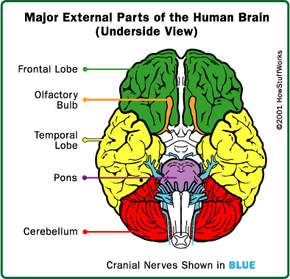Parts of the Brain
The brain is made up of three major parts: the cerebrum, the cerebellum and the brain stem. The cerebrum is the largest part of the brain. It makes up most of the total brain. The cerebrum controls cognitive and sensory functions such as intelligence, memory, reasoning and emotions. The cerebellumin the back of the brain controls balance and movement. The brain stem connects the two hemispheres of the cerebrum to the spinal cord. It controls breathing, blood pressure, sleep cycles, consciousness and other body functions. In addition, there is a large mass of neurons beneath the cerebrum, called the thalamus. This small, but critical area relays sensory impulses to the cerebral cortex. For a more detailed explanation of the brain's function, see How Your Brain Works.
Scientists believe that consciousness depends on the constant transmission of chemical signals from the brainstem and thalamus to the cerebrum. These areas are connected by neural pathways called the Reticular Activating System (RAS). Any interruptions to these messages can put someone into an altered state of consciousness.
Advertisement
A vegetative state is a type of coma that represents an awake but unresponsive state of consciousness. Many of these patients were comatose previously and after a few days or weeks emerge to an unconscious state in which their eyelids are open, giving the impression that they are awake. Patients in this state of consciousness may exhibit behaviors that lead family members to incorrectly believe they are becoming awake and communicative. These behaviors can include grunting, yawning and moving the head and limbs. However, these patients do not actually respond to any internal or external stimuli and evidence of extensive brain damage still persists. The outcome of patients in whom a vegetative state lasts for a month or more is generally poor and doctors use the term persistent vegetative state.
Next, we'll find out how someone can become comatose.
